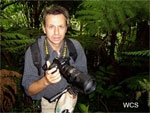|
|
A newly discovered species of chameleon from Tanzania has been named after Dorjee Sun, CEO of Carbon Conservation, an outfit which seeks to make rainforest conservation profitable through a carbon market mechanism known as REDD for Reducing Emissions from Deforestation and Degradation.
The blue-spotted species is now known as “Kinyongia dorjeesuni“. The name was bestowed during a benefit for the African Rainforest Conservancy, a group that is working to conserve and restore African rainforests.
Sun joins a distinguished list of previous ARC New Species Award recipients, including actor Harrison Ford, actor James Gandolfini, journalist George Plimpton, Conservation International Chairman and CEO Peter Seligmann, professor Michael Oppenheimer, and environmental activist Gloria Flora.
Sun says his efforts are putting a value on rainforests as living entities.
“Every day we lose 71,000 football fields of pristine rainforest by forestry companies,” said Sun. “We can continue to kick around on the fringe of irrelevancy, or step up to the plate and make a real difference?”
“If we lose rainforests, which we will by 2050 if deforestation continues at the current rate, we lose the fight against climate change. Deforestation releases more CO2 into the atmosphere than all the world’s cars, trucks, and airplanes combined” said Sun. “We all discuss the climate crisis as urgent, but stopping deforestation is one of the quickest and most cost effective ways to reduce global carbon emissions.”
Sun’s story is featured in The Burning Season, a documentary appearing next week at the Tribeca Film Festival. The Burning Season follows Sun in his quest to conserve a vast tract of rainforest in the Indonesian province of Aceh ahead of the 2007 U.N. climate meeting in Bali. Shortly after the conference, Sun landed a deal that could eventually generate more than $400 million in carbon finance. Benefits would extend to local communities and, more broadly, the planet.
“Forest carbon is the first link between financial markets and our earth’s infrastructure,” Sun told mongabay.com. “REDD payments are good for the forests and forests are good for the planet.
Dorjee Sun’s Chameleon
The newly described species of chameleon lives in the Eastern Arc Mountains of Tanzania, a chain that has nearly 100 species of endemic vertebrates, including reptiles, birds, and amphibians, and even primates — in 2005 a previously unknown species of money was discovered in a remote area. But these unique species are under threat — more than 70 percent are endangered due to forest clearing and unsustainable hunting practices. The African Rainforest Conservancy is working to change this through community conservation projects in more than 130 villages.
Related articles
17 new reptile and amphibian species discovered in Tanzania

(01/04/2009) 17 previously unknown species of reptiles and amphibians have been discovered in the rainforests of eastern Tanzania, report Italian and Tanzanian scientists. Conducting surveys of the ‘virtually unexplored’ forests of the South Nguru Mountains between 2004 and 2006, Michele Menegon of the Natural Science Museum of Trento in Italy and colleagues recorded 92 species of ‘herps’, of which 17 had never before been documented. The new species — which include chameleons, tree frogs, and snakes, among others — are believed to be endemic to the region.
Newly discovered monkey is critically endangered by logging, poaching
(07/28/2008) A newly discovered species of monkey may already be threatened with extinction, according to a study published in the journal Oryx.
Giant shrew discovered in Tanzania
(02/01/2008) More than a quarter larger than all of its relations, the Grey-faced sengi (Rhynchocyon udzungwensis) was first discovered on a roll of film from camera traps set-up in the Udzungwa Mountains of Tanzania. The photos of this mysterious giant elephant-shrew were sent to expert Dr. Galen Rathbun, who has studied the sengi (or elephant-shrew) for over thirty years; after examiining the photos he believed that the animal’s unique coloring proved it was an unknown species.
Conserving wildlife in Tanzania, Africa’s most biodiverse country

(11/09/2006) With ecosystems ranging from Lake Tanganyika to Mt. Kilimanjaro, Tanzania is the most biodiverse country in Africa. Though Tanzania is world famous for its safari animals, the country is also home to two major biodiversity hotspots: coastal forests of Eastern Africa and the montane forests of the Eastern Arc Mountains. Tanzania has set aside nearly a quarter of its land mass in a network of protected areas and more than one-sixth of the country’s income is derived from tourism, much of which comes from nature-oriented travel. Despite these conservation achievements, Tanzania’s wildlands and biodiversity are not safe. Fueled by surging population growth and poverty, subsistence agriculture, fuelwood collection, and timber extraction have fragmented and degraded extensive areas that are nominally protected as parks. Hunting and unsustainable use of forest products have further imperiled ecosystems and species. In the near future, climate change looms as a major threat not only to Mt. Kilimanjaro’s glaciers, which are expected to disappear within ten years, but also to Tanzania’s many endemic plants and animals found in its montane forests. Working to better understand these threats and safeguard Tanzania’s biodiversity for future generations is Tim Davenport, Country Director for the Wildlife conservation Society (WCS) in Tanzania.
Previously undiscovered species found in Tanzania
(06/22/2006) The first field surveys of the Rubeho Mountains in Tanzania revealed over 160 animal species–including a new species of frog and eleven endemic species–according to an article published in the African Journal of Ecology this month. The findings elevate the importance of protecting this biologically-rich wilderness area and the broader Eastern Arc Mountain range from destructive activities underway such as clear-cutting for agriculture, logging and poaching.